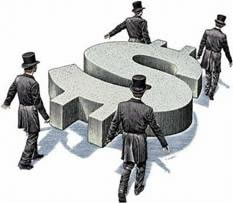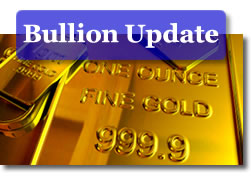Good Day,
Following Monday’s give-up of Friday’s hard-fought gains, gold prices headed lower still in the early Tuesday trading hours. The yellow metal hit a fresh, six-and-a-half week low in spot levels, under $1085 per ounce. At least three culprits stood out in the suspect line-up like sore thumbs today as well: the dollar, thin market conditions, and profit-takers.
Moody’s decision to downgrade Greek sovereign debt from A1 to A2, albeit still higher than Fitch’s and S&P’s, added to credit jitters this morning and supported strength in the US dollar (last seen at 1.428 against the euro). And, while few talk about oil anymore (as related to gold) it is worth noting that black gold has not only not fallen along with bullion, but has managed to remain extremely resilient. Could it be a case of "Old Man Winter" or is there something more to this? Like, say, Iraq/Iran, and/or Nigeria? Stay tuned – it is probably a combination of those factors.
Spot gold dealings opened with a $5.30 loss in New York this morning, quoted at $1086.00 per troy ounce as the US dollar hovered above 78.10 on the trade-weighted index. The bulk of the decline’s structure was made up by predominant physical selling however. "A failure to surmount the $1,098-$1,100 an ounce resistance area could lead to disappointment, and could spark fresh liquidations", analysts at GoldEssential.com observed. Support is now thought to be found only around the $1,072.60-$1,070 (Oct 14 rally high), then the $1,050 level, and, ultimately near the $1,026.50 (Sept 17 rally high) mark.
Elliott Wave analysts remain of the opinion that the recent correction is perhaps less a correction than the start of something more…ursine in nature: "The selling pressure in gold is, for now, unabated. Prices declined beneath last Thursday’s $1094.55 low in a continuation of the decline that started at the $1227.20 peak (Dec. 3). The next area of support is wide, in the $1022-$1071 area. As we’ve discussed, eventually gold should come under the wave A (circle) low at $680 before the wave structure can be counted as complete. Any bounce will encounter initial resistance at $1143. The main trend in gold is now down and should remain so until wave C (circle) can be counted as complete."
Fresh US GDP data threw a bit of a hot-cold mix onto the markets this morning. According to Marketwatch: "The U.S. economy grew at the fastest pace in two years during the third quarter, but the revised annual growth rate of 2.2% was much slower than initially reported, the Commerce Department estimated Tuesday." Thus, Q3 data –seen as dollar-supportive and bullion-hampering, was offset by YTD data –seen as not-so-dollar-friendly. What’s a trader to do? Probably keep reaching for the eggnog. This day is too young to draw any conclusions just yet. Gold quickly erased its early morning losses on the news, only to fall back into the "red zone" about ten minutes later…
Silver opened with a 12-cent loss, quoted at $16.85, and, it too, appeared to be aiming towards lower support areas (in the low $15’s presumably) that would hopefully elicit some bargain hunters to focus on it rather than holiday cheers at this time. Platinum lost $7 on the open, falling to $1408 per ounce, while palladium fell $4 to start at $357 per ounce. No change was reported in rhodium as it remained steady at $2340.00 per ounce.
Three, internationally-flavoured news bits this morning: 1) India will likely lose the crown of top global gold buyer this year (you-know-what is to blame). 2) Platinum frenzy is gripping China, to the point where analysts believe it will outperform gold in that country 3) Canada‘s Royal Mint has figured out where its missing gold went: most of it was simply mis-counted.
Okay, time for some year-end wisdom. One of the best observations comes to us from our friends over at RBC Wealth Management. You might use the sections in red to remind your favorite newsletter scribe that all is not what is appears to be, screaming from the rooftops notwithstanding. Certainly not as regards the ‘defunct’ US dollar:
"In these final illiquid trading sessions as we lead up to the end of the year we have time to ponder on some of the issues that have been constantly highlighted as meaningful in the most extraordinary of years. As a friend of ours pointed out to us only this week the USD looks to be ending 2009 a mere four — yes 4 — cents lower against the Euro than where it was at the end of 2008, and 4 cents higher than where it was at the end of 2007, and against the Swiss franc the difference is only two cents. Against the Yen the Dollar is almost exactly where it was at the end of 2008. In other words — against the world’s major currencies the Dollar has really not weakened at all when taken on a two year on year basis.

The other year-end musing comes from Capital Economics in London (yes, the team that foresees sub-$1000 gold in 2010). Referring to the Lost Decade in Japan and the recent crisis in the West, the team says that the jury might be out on what kind of decade we face:
"Although the policy response in the West has been quicker and more effective in some respects, the similarities between Japan’s Lost Decade and the crisis from which many Western economies are now only gradually emerging seem much larger than the differences. The good news is that Japan’s Lost Decade was not a complete write-off. Average economic growth was positive and not that far under Japan’s relatively low sustainable rate. However, a similarly prolonged period of below-par growth in the Western economies could still disappoint many in the years ahead."
Remain on alert for wacky price swings, oddball chart moves, irrational bets, and other assorted market high jinks. Ah, the holidays. Play them safe. Many shiny bits are highly flammable.
Jon Nadler
Senior Analyst
Kitco Metals Inc.
North America
Blog: http://www.kitco.com/ind/index.html#nadler
For the Royal Canadian Mint release on it’s gold finding, read Gold Fully Accounted For At Royal Canadian Mint. Check out other site market resources at Precious Metals Prices, Silver Coins Values and the US Inflation Calculator which easily finds how the buying power of the dollar has changed from 1913-2009.











